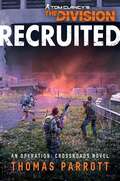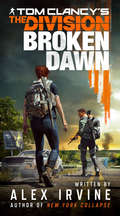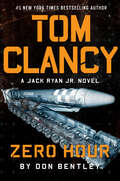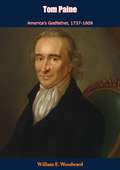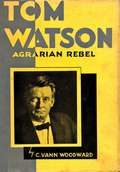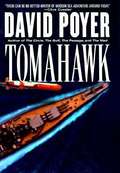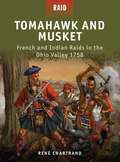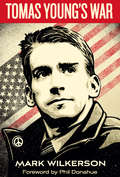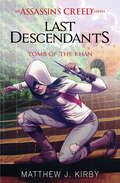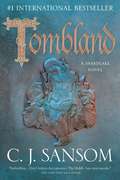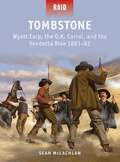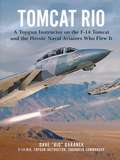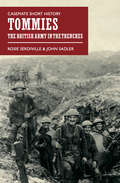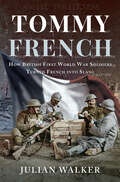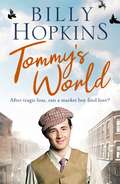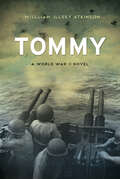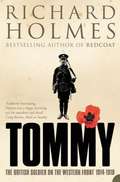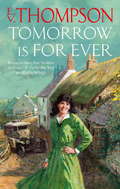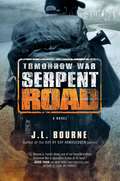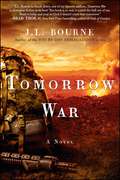- Table View
- List View
Tom Clancy's The Division: An Operation: Crossroads Novel (Tom Clancy’s The Division)
by Thomas ParrottA newly recruited agent is the Strategic Homeland Division&’s best hope to prevent a nefarious plot from ripping the agency apart, in this brand new post-apocalyptic thriller from Tom Clancy&’s The Division® Maira Kanhai has had enough: since the Green Poison epidemic hit DC, her Cybersecurity degree is worthless, she can&’t rejoin the US Navy, and her early efforts to secure Maryland led to a costly mistake: the death of her brother. Every day new factions emerge, trying to burn her city to the ground – until the Division emerges, inspiring hope. When a grenade kills one of their agents, Maira suddenly has a chance to make a real difference as a raw new Division recruit … if she can pass the tests, and overcome the enemies plotting to permanently eliminate the Division once and for all.
Tom Clancy's The Division: Broken Dawn
by Alex IrvineImmerse yourself into the fractured vision of the post-pandemic world from Tom Clancy’s The Division® 2 through this new story.Months after the outbreak of a devastating global pandemic that started in New York City on Black Friday, traces of rebirth are spreading across the United States. Spring has come to the nation, and with it a glimmer of hope as civilians band together in settlements, trying to carve out a better life. Amidst a ruined government, a shattered infrastructure, and an eroding civilization, The Division – an autonomous unit of sleeper agents activated when all else fails – is all that protects the people from predators who would harm them, scavengers who would take from them, and oppressors who would exploit them. Aurelio Diaz is one of those agents. A man of great honor, he is on the hunt for one of his colleagues who inexplicably abandoned his duty and caused the death of multiple civilians. This trail leads him to April Kelleher, a resourceful civilian who traveled out of New York into a troubled American Midwest. There, she hopes to understand why her husband was murdered and if an antiviral to the deadly disease exists. Together, Agent Diaz and April soon uncover an imminent threat to the future of the country. They must act to preserve civilization’s last hope to stop a new virus and save itself from a final collapse.
Tom Clancy: Zero Hour (A Jack Ryan Jr. Novel #9)
by Don BentleyJack Ryan, Jr. is the one man who can prevent a second Korean War in the latest thrilling entry in the #1 New York Times bestselling series. <p><p>When the leader of North Korea is catastrophically injured, his incapacitation inadvertently triggers a “dead-man’s switch,” activating an army of sleeper agents in South Korea and precipitating a struggle for succession. Jack Ryan, Jr. is in Seoul to interview a potential addition to the Campus. But his benign trip takes a deadly turn when a wave of violence perpetrated by North Korean operatives grips South Korea’s capital. <p><p>A mysterious voice from North Korea offers Jack a way to stop the peninsula’s rush to war, but her price may be more than he can afford to pay. <p> <b>New York Times Bestseller</b>
Tom Paine: America's Godfather, 1737-1809
by William E. WoodwardThe purpose of this biography is to present a true picture of Tom Paine and his place in American history. This means that both his good and bad qualities should appear, and as I had no prejudice in the matter and no predetermined opinion of Paine and his accomplishments, it would seem, on first consideration, that the preparation of the book would not be a very difficult task. But it has turned out to be extremely complicated, for the reason that the data concerning Paine have been overlaid by such an accumulation of lies, false impressions, twisted remarks, and untrue and slanderous episodes that the most intensive research has been required.That he inspired the Declaration of Independence and is the godfather of the free American nation is either unknown or disregarded. That he was the most potent advocate during the whole of the eighteenth century for human freedom, equality of men, free education, universal suffrage, and rights of women is also a neglected fact.
Tom Watson: Agrarian Rebel (History Of The United States Ser.)
by C. Vann WoodwardSouthern Populist leader Thomas E. Watson was a figure alternately eminent and notorious. Born before the Civil War, he lived through the turn of the century and past the close of the First World War, pursuing his career in an era as changing and paradoxical as himself. In the nineteenth century, Watson championed the rising Populist movement, an interracial alliance of agricultural interests, against the irresistible forces of industrial capitalism. The movement was broken under the wheels of the industrial political machine, but survived into the twentieth century in various "fantastic shapes...to be understood mainly by the psychology of frustration." Political frustration transformed Watson as well, from liberal to racial bigot and from popular spokesman to mob leader. In this biography, through careful study of public and private writings, and through objective and tolerant exposition, Mr. Woodward has attempted to solve the enigma of this man who did much to alter his times and who was, in turn, altered by them."Mr. Woodward's biography of Watson is a model of its kind. It has all the obvious qualities of scholarship, thoroughness and impartiality. It has, in addition, a sympathetic understanding of broad social movements, a mature appreciation of character, an original interpretation of economic facts and factors, an incisive criticism of political techniques, and a literary style that is always vigorous and sometimes brilliant."--H. S. Commager, New York Herald Tribune Books"Mr. Woodward's biography of Watson constitutes the best one-volume history that has appeared of that first crop of social ideals, politically garnered in Populism...Mr. Woodward's biography is also valuable in that it is something more than the story of Populism. It is a striking portrait of a man."--W. A. White, Saturday Review of LiteratureIncludes the Author's Preface to the 1955 Reissue.
Tomahawk (A Dan Lenson Novel #5)
by David PoyerDavid Poyer's cycle of nautical adventures featuring Navy officer Dan Lenson have been acclaimed as some of the finest sea novels of our time. With Tomahawk, Poyer offers his most thoughtful, suspenseful, and morally complex book to date. In the wake of a collapsed marriage and three stressful tours at sea, Lieutenant-Commander Lenson is ordered to shore duty in Washington, D.C. There he finds he's been handpicked for a high-priority, top-secret assignment: design, test, and deploy Tomahawk missiles armed with nuclear warheads. But as Dan moves into the thick of top-level Pentagon politics, he realizes that the trouble-prone new missile has powerful enemies, determined to destroy it and him. Troubling leaks from the program seem to suggest a spy is at work, and Dan comes under suspicion. Meanwhile, he finds himself unexpectedly-- perhaps unwisely-- falling in love with Kerry Donovan. Kerry is a peace activist, soon to go on trial for her protests, and Dan's involvement with her challenges the core of his beliefs and duties-- and finally his character. With riveting action scenes on land and at sea, powerfully felt dilemmas of conscience, and an explosive climax, Tomahawk is an unforgettable journey through the corridors and currents of official Washington and the U.S. Navy.
Tomahawk and Musket - French and Indian Raids in the Ohio Valley 1758
by Peter Dennis Rene ChartrandIn 1758, at the height of the French and Indian War, British Brigadier General John Forbes led his army on a methodical advance against Fort Duquesene, French headquarters in the Ohio valley. As his army closed in upon the fort, he sent Major Grant of the 77th Highlanders and 850 men on a reconnaissance in force against the fort. The French, alerted to this move, launched their own counter-raid. 500 French and Canadians, backed by 500 Indian allies, ambushed the highlanders and sent them fleeing back to the main army. With the success of that operation, the French planned their own raid against the English encampment at Fort Ligonier less than fifty miles away. With only 600 men, against an enemy strength of 4,000, the French & Amerindians launched a daring night attack on the heart of the enemy encampment. This book tells the complete story of these ambitious raids and counter-raids, giving in-depth detail on the forces, terrain, and tactics.
Tomas Young's War
by Mark WilkersonTomas Young’s War is the tragic yet life affirming story of a paralyzed Iraq War veteran who spent his last ten years battling heroically with his injuries, while courageously speaking against America's wars.<P><P> Based on hours of interviews with Young and those close to him, the book puts the reader alongside Young as he struggles with life as a paralyzed veteran, suffering frustration and humiliation as he attempts to reenter society and resume as normal an existence as possible. It shows his fight to balance his precarious health with his drive to speak out for veterans care and against the war, and the impact his catastrophic injuries had on his family and his relationships.<P> This emotional and powerful book sheds light on many crucial but often overlooked issues such as veterans’ care, public attitudes toward the disabled, medical marijuana, and the terminally ill. Tomas Young’s War shares everything, as unflinchingly honest as Tomas himself: the depression, the pain, the love, and laughter...the life of this man whose world was turned upside down by an Iraqi bullet more than ten years ago. Throughout, it serves as a powerful testament to the true cost of war.
Tomb of the Khan: An Assassin's Creed Novel Series #2) (Last Descendants: An Assassin's Creed Series #2)
by Matthew J. KirbyOwen and his friends are back and deep in simulations of Mongolian China. The second book in the Last Descendants trilogy based on the Ubisoft(R) video game franchise "Assassin's Creed"!As the second book in the Last Descendants trilogy begins, Owen and his friends have lost. When they located the first piece of an ancient and powerful relic long considered a legend - the Trident of Eden - it seemed little could stop them. This piece was sought by the Brotherhood of Assassins and the Templar Order, but before either organization could take the piece, it was stolen by an unknown third party. The relationship between the teens fractured-Owen and his friend Javier taking sides with the Assassins, the others with the Templars.Now there are still two pieces of the Trident of Eden to find, and both are determined not to repeat their mistakes. The next piece is said to have been buried with the Mongol warlord Mongke Khan, whose tomb has never been found. Teens on either side of the conflict will have to go into simulations in war-torn Mongolian China in a race against time to discover the next piece, and ensure their safety before their enemies find it first.
Tombland (The\shardlake Ser. #7)
by C. J. Sansom"The latest in what is easily one of the best ongoing mystery series currently being published" (Christian Science Monitor), a mystery for fans of Hilary Mantel, set in a time of great political upheaval in Tudor-era England.Spring, 1549. Two years after the death of Henry VIII, England is sliding into chaos.The nominal king, Edward VI, is eleven years old. His uncle, Edward Seymour, Lord Hertford, rules as Edward's regent and Protector. In the kingdom, radical Protestants are driving the old religion into extinction, while the Protector's prolonged war with Scotland has led to hyperinflation and economic collapse. Rebellion is stirring among the peasantry.Matthew Shardlake has been working as a lawyer in the service of Henry's younger daughter, the lady Elizabeth. The gruesome murder of one of Elizabeth's distant relations, rumored to be politically murdered, draws Shardlake and his companion Nicholas to the lady's summer estate, where a second murder is committed.As the kingdom explodes into rebellion, Nicholas is imprisoned for his loyalty, and Shardlake must decide where his loyalties lie -- with his kingdom, or with his lady?
Tombstone - Wyatt Earp, the O.K. Corral, and the Vendetta Ride 1881-82
by Sean Mclachlan Mark StaceyThe Gunfight at the OK Corral on 26 October 1881 is one of the most enduring stories of the Old West. It led to a series of violent incidents that culminated in the Vendetta Ride, in which Wyatt Earp, Doc Holliday, and several other gunslingers went after their rivals the Cowboys.Like most tales of the Wild West, the facts are buried under layers of myth, and the line between good guys and bad guys is blurry. Wyatt Earp, leader of the so-called "good guys", was charged with stealing horses in the Indian Territory in 1870 and jumped bail. Becoming a buffalo hunter and gambler, he got into several scrapes and earned a reputation as a gunfighter. Several times he helped lawmen arrest outlaws, but usually his assistance came more because of a personal grudge against the criminal than any real respect for law and order. He even got fired from a police job in Wichita for beating up a political rival. So it was in Tombstone. He settled there in 1879 along his three brothers and "Doc" Holliday. Virgil and Morgan Earp worked as lawmen. As the Earps became a power in the town, investing in some businesses and starting others, they were soon at loggerheads with the Clanton Gang, the so-called "Cowboys." In that time and place, honest cowboys called themselves "ranchers" and the term "cowboy" was reserved for rustlers and other unsavory characters.The Tombstone Cowboys had Cochise County sheriff John Behan in their pocket and the struggle between the Earps and Cowboys was partially a political rivalry. It was also because the Earps had invested in the stagecoaches and the Cowboys liked to rob them. There was an element of lingering differences over the Civil War as well, something common in Wild West feuds. The Earps and friends were mostly Republican Northerners, while the Cowboys were mostly Democrats and former Confederates. This distinction wasn't clear cut, however, as at least one Confederate veteran rode with the Earps. Brawls and threats between the two sides became more frequent and culminated in a showdown near the OK Corral. Several Cowboys were loitering around hoping to attack Doc Holliday, so the Earps and Holliday decided to arrest them on the grounds that they were carrying weapons in town. In the shootout three Cowboys were killed and Virgil and Morgan Earp wounded.The Cowboys thirsted for revenge and shot Morgan Earp in the back five months later. Virgil was crippled in a separate shooting. Taking Morgan's body to Tucson, the surviving Earp brothers and Holliday spotted Frank Stillwell, one of the Cowboys suspected of murdering Morgan. They shot him down. A large posse under John Behan, including many Cowboys, chased after the Earps but never caught them.
Tomcat Rio: A Topgun Instructor on the F-14 Tomcat and the Heroic Naval Aviators Who Flew It
by Dave BaranekFrom Topgun to Squadron Command You&’re in the cockpit of the legendary F-14 Tomcat fighter, blazing along at twice the speed of sound seven miles above the ocean and the carrier that hurled you off its deck. You&’re practicing dogfighting with &“aggressors,&” guys on your side flying F-16s. You&’re patrolling the tense skies above Iraq, and with the push of a button you can launch the 100-mile Phoenix missile that can blow a foe to scrap before you even see him. You are an expert in fighter tactics and aircraft carrier operations, and it all leads to your command of an F-14 fighter squadron of more than three hundred people. Sounds like a week&’s worth of daydreams, but it&’s all real-life in the career of Dave &“Bio&” Baranek, and he shares it with you in the exciting, superbly crafted new book, Tomcat Rio. Dave – callsign &“Bio&” – pulled his readers into the exciting world of the F-14 and the Navy&’s TOPGUN program with his popular books Topgun Days and Before Topgun Days. Now he&’s back with the rest of the story, as he reaches the top level of expertise and proves it, not just in graded competitions but also where it counts, where you shoot at them and they shoot at you. Dave also shares the challenges he faced. A deadly foe called complacency. Learning a whole new mission late in his career. The unexpected trials that come with leading a squadron in the dynamic environment of Naval Aviation. This third volume is full of adventures, lessons, and inspiration. If you are a casual reader, you&’ll turn the last page as a dedicated Tomcat fan. To make it all even more real, Tomcat Rio includes dozens of Bio&’s best and most acclaimed photos. Photographer George Hall hailed one shot as &“one of the best Tomcat photos ever taken.&” In words and pictures, Bio immerses you in rich detail. He pipes you aboard as a member of an F-14 squadron. You share the camaraderie of Type A personalities. You plan risky missions, going toe-to-toe against America&’s most volatile foes. You can almost smell the pungent jet exhaust, almost feel the gut-wrenching G&’s of a dogfight, as Tomcat Rio pitches you into the thick of it as only Bio can tell it. Strap in! You&’re going for one fantastic ride.
Tommies: The British Army in the Trenches (Casemate Short History)
by John Sadler Rosie Serdiville&“Everything you need to know to get you started on the subject of the men of the British Army who found themselves in the trenches in WWI. Superb.&” —Books Monthly British soldiers have been known as Tommies for centuries, but the nickname is particularly associated with the British infantryman in the trenches of World War I. In August 1914, a small professional force of British soldiers crossed the Channel to aid the French and Belgians as the German army advanced. As it became apparent that the war would not, in fact, be over by Christmas, a vast drive for volunteer soldiers began. As enthusiasm for enlistment tailed off, eventually conscription was introduced in order to replenish the forces weakened by years of bloodshed. By 1918 the British army was transformed, fielding 5.5 million men on the western front alone. These Tommies fought an entirely new type of war, living in vast trench systems, threatened by death from the air and gas attack as well as by bullet, bomb, or bayonet. This introduction explores the experience of Tommies on the western front, explaining how their war evolved and changed from the mobile battles of August 1914 to the final days of the war, and discussing daily life as an infantryman on the front line using firsthand accounts, contemporary poems, and songs. The Casemate Short History Series &“would be excellent for someone with an early interest in military history or for someone talking history at school. Very readable and easy to understand with some good illustrations&” (Army Rumour Service).
Tommy Atkins: The Story of the English Soldier
by John LaffinTommy Atkins is the English soldier, who joking broke the cavalry of France at Minden, who singing marched with the Great Duke to the Danube, who grumbling shattered Napoleon's dreams at Waterloo, who sweating in his red coat tramped back and forth across Indis, who kept his six-rounds-to-the-minute at Mons, and who died in the mud at Passchendaele, the sands of the Western Desert, and the jungles of Burma. If his name has been eclipsed by his more illustrious commanders - Cromwell, Marlborough, Moore, Wolfe, Wellington, Allenby, Slim - they at least will accord him his rightful place beside them. They knew his worth. Tommy Atkins is his story - the story of this most versatile, most adaptable, most unmilitary soldier.
Tommy French: How British First World War Soldiers Turned French into Slang
by Julian Walker‘Napoo’, ‘compray’, ‘san fairy ann’, ‘toot sweet’ are anglicized French phrases that came into use on the Western Front during the First World War as British troops struggled to communicate in French. Over four years of war they created an extraordinary slang which reflects the period and brings the conflict to mind whenever it is heard today. Julian Walker, in this original and meticulously researched book, explores the subject in fascinating detail. In the process he gives us an insight into the British soldiers’ experience in France during the war and the special language they invented in order to cope with their situation. He shows how French place-names were anglicized as were words for food and drink, and he looks at what these slang terms tell us about the soldiers’ perception of France, their relationship with the French and their ideas of home. He traces the spread of ‘Tommy French’ back to the Home Front, where it was popularized in songs and on postcards, and looks at the French reaction to the anglicization of their language.
Tommy French: How British First World War Soldiers Turned French into Slang
by Julian Walker‘Napoo’, ‘compray’, ‘san fairy ann’, ‘toot sweet’ are anglicized French phrases that came into use on the Western Front during the First World War as British troops struggled to communicate in French. Over four years of war they created an extraordinary slang which reflects the period and brings the conflict to mind whenever it is heard today. Julian Walker, in this original and meticulously researched book, explores the subject in fascinating detail. In the process he gives us an insight into the British soldiers’ experience in France during the war and the special language they invented in order to cope with their situation. He shows how French place-names were anglicized as were words for food and drink, and he looks at what these slang terms tell us about the soldiers’ perception of France, their relationship with the French and their ideas of home. He traces the spread of ‘Tommy French’ back to the Home Front, where it was popularized in songs and on postcards, and looks at the French reaction to the anglicization of their language.
Tommy Goes to War
by Malcolm BrownThe image of the innocent British soldier (or Tommy) setting off with a spring in his step in 1914 to fight the Great War would not last long.Indeed that initial euphoria would soon give way to a deep-seated bitterness as these young men endured the horror of the First World War.In a new edition of this extraordinary book, the uncensored letters, diaries, documents and many photographs tell the story of the British soldier (nicknamed Tommy) in their own words.While there are flashes of their wit and humour, the overwhelming feeling is that of a generation who felt let down by their superiors and left to perish.There are visceral, terrifying insights into life in the trenches and agonising descriptions of the squalor and privations of war.This haunting account also looks at the aggressive drive to recruit more soldiers through the Pals Battalion or Chums Battalion. Friends from the same town or village; professional bodies, or work colleagues among others were encouraged to enlist en masse. They would fight together alongside their friends or colleagues. Many of them would sadly die together and leave communities wild with grief for a lost generation, robbed of a future having barely had a past.With a concise analysis of the British Army in the First World War, we are reminded of the terror of war, the fury, the fear and the frustration of what has been described by some as a war typified by the devastating assessment: lions led by donkeys.
Tommy's World (The Hopkins Family Saga, Book 3): A warm and charming tale of life in northern England
by Billy HopkinsA Manchester lad's life in the early twentieth century - the slums, Smithfield market and the search for love... Billy Hopkins bases his engaging novel, Tommy's World, on the fascinating and inspiring life of his father Tommy, born in a Manchester slum in 1886. Perfect for fans of Lindsey Hutchinson and Maureen Lee.'The characters will stay with you after you've finished the book, but what you won't be left with is the sickly sweet taste of nostalgia. If you like to learn something from a good story then this could well be the book for you' - The BookbagTommy Hopkins' early years aren't very promising. Born at the end of the nineteenth century in a slum district of Manchester, he's blessed with a loving, hard-working mam and dad, but they don't have two ha'pennies to rub together. The family is struck by tragedy not once but twice - but Tommy is a survivor. He quickly makes friends at school, and together they plot money-making schemes, settle scores and play lots of football. Then, at last, it's time to leave the playground behind. Denied the chance of a promising career as an engineer, Tommy finds employment at Manchester's Smithfield market and works his way up, finally becoming a porter. He's turning into a man, and amongst the young women who catch his eye is Kate Lally, who may just be the love of his life...What readers are saying about Tommy's World: 'Well written and the characters are just so great... you enter a different world when you read a Billy Hopkins book''Brilliant author, his books are really ones that you can't put down!''Tommy's World was superb. Fascinating detail about life as it was. Unputdownable'
Tommy's World: A warm and charming tale of life in northern England (Hopkins Family Saga #1)
by Billy HopkinsA Manchester lad's life in the early twentieth century - the slums, Smithfield market and the search for love... Billy Hopkins bases his engaging novel, Tommy's World, on the fascinating and inspiring life of his father Tommy, born in a Manchester slum in 1886. Perfect for fans of Lindsey Hutchinson and Maureen Lee.'The characters will stay with you after you've finished the book, but what you won't be left with is the sickly sweet taste of nostalgia. If you like to learn something from a good story then this could well be the book for you' - The BookbagTommy Hopkins' early years aren't very promising. Born at the end of the nineteenth century in a slum district of Manchester, he's blessed with a loving, hard-working mam and dad, but they don't have two ha'pennies to rub together. The family is struck by tragedy not once but twice - but Tommy is a survivor. He quickly makes friends at school, and together they plot money-making schemes, settle scores and play lots of football. Then, at last, it's time to leave the playground behind. Denied the chance of a promising career as an engineer, Tommy finds employment at Manchester's Smithfield market and works his way up, finally becoming a porter. He's turning into a man, and amongst the young women who catch his eye is Kate Lally, who may just be the love of his life... What readers are saying about Tommy's World: 'Well written and the characters are just so great... you enter a different world when you read a Billy Hopkins book''Brilliant author, his books are really ones that you can't put down!''Tommy's World was superb. Fascinating detail about life as it was. Unputdownable'
Tommy: A World War II Novel
by William Illsey AtkinsonA mathematician finds himself in the midst of the Pacific War in this &“historical novel that can be appreciated by anyone, not just the history buffs&” (Scene magazine). April 1945: In the aftermath of the battle for Okinawa, Tommy stands on the deck of the USS Bataan, the Independence-class aircraft carrier that he&’s called home for a year. Once, he was a student in the classrooms of MIT. Now, thousands of miles away, he is surrounded by horrors—but uses his mathematical and navigational expertise to do his best to minimize the casualties. In this novel, William Illsey Atkinson tells the story of Japan&’s Operation Ten-Go, and the fierce battle that sent dozens of vessels to their watery grave while hundreds of others were damaged from the air. Tommy spans the vast experience of one man&’s life, from his hardscrabble childhood in early twentieth-century Dorris, California, to his heroic efforts in the South Pacific and beyond.
Tommy: The British Soldier on the Western Front, 1914-1918
by Richard Holmes"Tommy" tells the story of the First World War through the experiences of those who fought it. Using previously unseen letters, diaries, memoirs, and poetry from the years 1914-1918, Richard Holmes paints a moving picture of the generation that fought and died in the mud of Flanders. He follows men whose mental health was forever destroyed by shell shock, women who lost husbands and brothers in the same afternoon, and those who wrote at lunchtime and died before tea. Groundbreaking and critically-acclaimed, this book tells the real story of trench warfare, the strength and fallibility of the human spirit, the individuals behind an epic event, and their legacy.
Tomorrow Is For Ever
by E. V. ThompsonFor Alan Carter the greatest personal sacrifice of the Great War of 1914-18 is being called-up after only one week of marriage. Leaving his new bride is even more painful than the wound that, months later, interrupts his war at sea and sends him to Cornwall to convalesce. For, there, he has time to think about Dora and about the career as a writer that he secretly nurtures. A career that seems possible when he finds himself accepted by the established colony of Newlyn artists. There is one artist in particular - Vicky Hazleton - who encourages Alan's leanings towards the arts. And she stirs other feelings: inappropriate and impossible ones. For Vicky and her set inhabit a different world from Alan. He, as one of Vicky's friends makes clear, belongs to London's East End - and to Dora . . .
Tomorrow Is for the Brave
by Kelly BowenBased on true events, Tomorrow Is for the Brave is a gripping World War II page‑turner about a courageous woman who risks it all for what is right—perfect for fans of Natasha Lester and Kristen Harmel.1939, France: Lavish parties, fast cars, and a closet full of the latest fashion—to the average eye, socialite Violet St. Croix seemingly has it all. But what she truly wants is a life full of meaning and purpose. So when France falls to Germany, Violet defies her parents&’ wishes and joins the war effort. With her impeccable skill for driving under pressure, she is soon sent to North Africa to shepherd French Foreign Legion officers carrying valuable intelligence through dangerous territory. But as the Allies encounter one mishap after another, Violet becomes convinced there is a spy in their ranks. And when her commanding officer is murdered, Violet realizes she might be the only one who can uncover the traitor and save the lives of countless soldiers on the front lines. Convincing others to believe her is difficult enough. Finding someone she can trust just might be impossible.
Tomorrow War: A Novel (The Chronicles of Max #2)
by J. L. BourneA riveting, ultra-realistic example of “dystopian fiction at its best” (Brad Thor, #1 New York Times bestselling author) from the acclaimed author of the Day By Day Armageddon novels!During an unacknowledged mission inside the Syrian border, a government operative had unwittingly triggered an incredible worldwide event that irrevocably shaped the future of the United States. In the aftermath of the crisis, families have struggled to survive in a world short on food, water, and electricity. Hyperinflation cripples the United States economy and post-war armored military vehicles are patrolling the streets. One man has now stepped forward and continues to push back the dark wave of tyranny brought on by martial law in the streets of America, and may be the only hope of saving liberty for the country&’s future.
Tomorrow War: The Chronicles of Max [Redacted] (The Chronicles of Max #1)
by J. L. BourneJ.L. Bourne&’s apocalyptic novel Day by Day Armageddon was praised by #1 bestseller Brad Thor as &“so real, so terrifying…that I slept with two loaded Glocks under my pillow.&” In this ultrarealistic military thriller, the collapse of America&’s power grid threatens the world&’s fate—and only those prepared for the ultimate catastrophe will survive.On an unacknowledged mission inside the Syrian border, a government operative unwittingly triggers an incredible event that unleashes a weapon with the power to destroy the moral fabric of humanity. As the crisis unfolds, hyperinflation cripples the US economy. Families struggle to find food, water, and electricity. Post-war armored military vehicles patrol the streets as martial law is imposed. The US government appears to offer salvation, but there is a sinister catch... One man stands up to push back against a high tech, tyrannical enemy hell-bent on ripping liberty from the pages of future history. But as vital supplies and makeshift weaponry are running out, so is time…and he will have to use every resource and survival tactic to fight for survival: for himself and his home.
